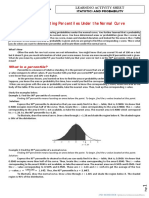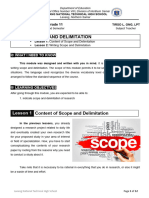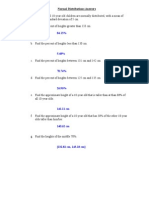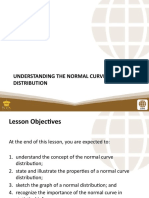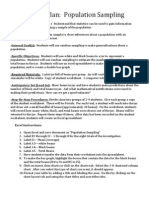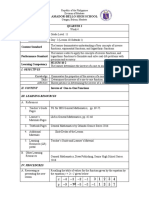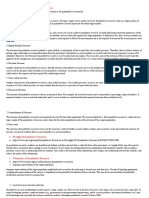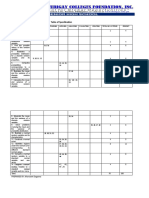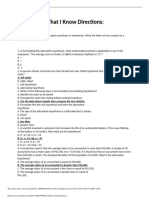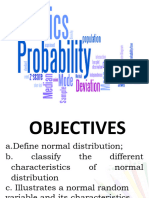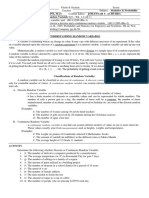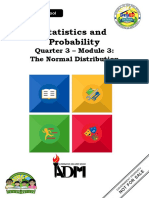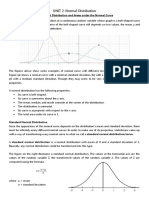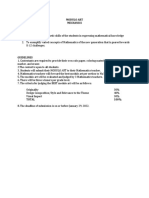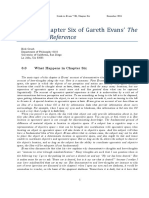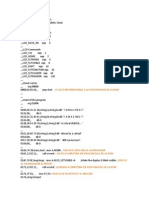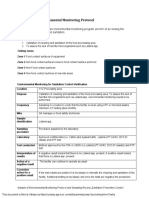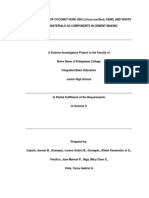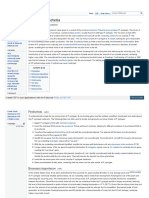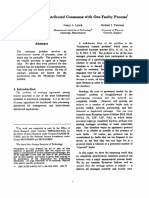LESSON 9-10
(Week 9-10)
APPLICATIONS OF NORMAL DISTRIBUTION
The learner…
Define the normal distribution operationally.
Solve problems pertaining to normal distribution.
Use the standard normal distribution table.
APPLICATIONS OF NORMAL DISTRIBUTION
z-score
The first step in finding the area under the normal curve is to convert the
normal curve of any given variable into a standardized score by using the formula.
z = x− ¿ ¿ where: x=any given value of a particular variable.
❑
z = standard score
=mean
=standard deviation
Z-score or Standard Score tells how many standard deviations a value is, away from
the mean. A negative z-score tells that the value is below the mean, while a positive z-
score tells that the value is above the mean. A z-score is unitless, thus, even values of
different units could be compared relative to their groups.
Examples: The score of students in the midyear examination for Mathematics has a
mean () of 32 and a standard deviation () of 5. Find the z-scores corresponding to
each the following:
37−32
a. 37 z = x− ¿ ¿ z= =5/5= 1 0.8413
❑ 5
¿ 22−32
b. 22 z = x− ¿ z= =-10/5= -2 0.0228
❑ 5
�Applications of Normal Distribution
In order to use the concepts of normal distribution, each of the values of a given
data are assumed to be transformed to standard scores. From this, a table (z-table) is
used to determine the fraction of values that lie below or above a given value, or
between two values. Also, values that bound a given fraction of the data can be
determined by the same table.
Note that the z-table gives a value of z up to two decimal places, thus, it is
preferred to round z-scores/standard scores to two decimal places.
Example 1:
The scores of a group of students in a standardized test are normally
distributed with a mean of 60 and standard deviation of 8. Answer the following:
a. How many percent of the students got below 72?
b. What part of the group scored between 58 and 76?
c. If there were 250 students who took the test, about how many students scored
higher than 64?
Answers:
72−60 12
a. z = x− ¿ ¿ z= = = 1.5
❑ 8 8
Referring to the z-table, the area below z=1.5 is 0.9332. Therefore, about 93.32% of
the group below 72.
58−60 −2
b. z = x− ¿ ¿ z= = = -0.25
❑ 8 8
76−60 16
z = x− ¿ ¿ z= = =2
❑ 8 8
Using the z-table, the area below z=-0.25 is 0.4013, while below z=2, the area is
0.9772. Therefore, the area between z=-0.25 and z=2 is 0.9772-0.4013=0.5759. Thus,
about 93.32% of the group got a score between 58 and 76.
64−60 4
c. z = x− ¿ ¿ z= = = 0.5
❑ 8 8
The area below z=0.5 is 0.6915, so the area above this is 1-0.6915=0.3085.
Since there were 250 students who took the test, about (200)(0.3085)=61.7or 62
students got a score higher than 64.
Example 2:
� A highly selective university only admits the top 5% of the total examinees in
their entrance exam. The results of this year’s entrance exam follow a normal
distribution with a mean of 285 and a standard deviation of 12. What is the least
score of an examinee who can be admitted to the university?
Look at the body of the z-table to find a value with 0.95, this means that 0.05 or
5% are above this. From the table, the value 0.9505 corresponds to 1.65 (intersection
of 1.6 and 0.05). The score 1.65 above (since z is +) is:
x−285
z = x− ¿ ¿ 1.65= (1.65)(12)=x-285 x=304.8 or 305
❑ 12
Example 3:
The weight of adults in Barangay X approaches a normal distribution with a
mean of 52.9 kg and a standard deviation of 7.2 kg. If an adult is chosen at random
from Barangay X, what is the probability that his weight is above 48.5 kg.
Answer:
48.5−52.9
Z= = -0.61
7.2
Looking at the table, the area below z=-0.61 is 0.2709. Therefore, the area
above it is 1-0.2709=0.7291. Hence, the probability that the randomly selected adult
weighs above 48.5 kg is 0.7291 or 72.91%.
Activity No. 1
A.Given a normal distribution with a mean of 42 and standard deviation of 6, find the
area BELOW:
1. 36
2. 54
� 36−42
z = x− ¿ ¿ z= =-6/6= -1= 0.1587
❑ 6
3. 38
4. 60
5. 58
6. 24
7. 30.5
A.Given a normal distribution with a mean of 42 and standard deviation of 6, find the
area BELOW:
¿ 36−42
1. 36 z = x− ¿ z= =-6/6= -1= 0.1587
❑ 6
54−42
2. 54 z = x− ¿ ¿ z= =12/6= 2 = 0.9772
❑ 6
38−42
3. 38 z = x− ¿ ¿ z= =-4/6 = -0.67 = 0.2514
❑ 6
¿ 60−42
4. 60 z = x− ¿ z= =18/6= 3 = 0.9987
❑ 6
58−42
5. 58 z = x− ¿ ¿ z= = 16/6= 2.67= 0.9962
❑ 6
6. 24 0.0013
7. 30.5 0.0274
B. Given a normal distribution with a mean of 125 and standard deviation of 15, find
the area ABOVE:
� 128−125
1. 128 z = x− ¿ ¿ z= = 3/15= 0.2 = 0.5793
❑ 15
1-0.5793 = 0.4207
119−125
2. 119 z = x− ¿ ¿ z= = -0.4 = 1- 0.3446= 0.6554
❑ 15
3. 158
4. 100
5. 120
6. 115
7. 160
C. Given a normal distribution with a mean of 24 and standard deviation of 4, find the
area BETWEEN the following:
1. 28 and 30
¿ 12−24
2. 12 and 38 z = x− ¿ z= = -12/4= -3 0.0013
❑ 4
38−24
z = x− ¿ ¿ z= = 14/4= 3.5 0.9998
❑ 4
0.9998-0.0013= 0.9985
¿ 16−24
3. 16 and 22 z = x− ¿ z= =-8/4= -2= 0.0228
❑ 4
22−24
z = x− ¿ ¿ z= = -2/4= -0.5=0.3085
❑ 4
0.3085-0.0228= 0.2857
¿ 19−24
4. 19 and 31 z = x− ¿ z= = -1.25 0.1056
❑ 4
� 31−24
z = x− ¿ ¿ z= = 1.75 0.9599
❑ 4
0.9599-0.1056= 0.8543
5. 17 and 24
6. 11 and 32 7. 25 and 35 8. 20 and 33 9. 23 and 29 10. 18 and 26
D. Solve the following:
1. The average length of adult rabbit is 30 cm with standard deviation of 4 cm. If their
lengths are normally distributed,
a. how many percent of adult rabbits are shorter than 28 cm?
b. how many percent of adult rabbits exceed 40cm in length?
c. if a rabbit is randomly chosen, what is the probability that its length is between 21
cm and 35 cm?
Reference
Reyes, A.C. (2016). Statistics and Probability. Philippines: Jimczyville Publications.












